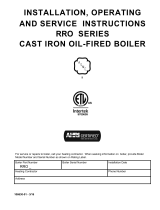Power-Up
Upon applying power (120 volts), the control will reset, perform a
self-check routine, monitor the flame sense input to verify no flame
is present and enter the thermostat scan state.
Call for Heat
When a call for heat is received from the thermostat supplying
120 volts to the TH terminal, the control will perform a self-check
routine, the safety timing sequence and flame check. After an
optional "pre-purge" period, the hot surface ignitor is energized for
a heat-up period, followed by the gas valve for the "trial for ignition"
(TFI) period. If flame is detected during purge, the gas valve will
remain de-energized.
Ignition
When a valid flame is detected during the TFI period, the ignitor is
de-activated and the gas valve remains energized. The thermostat
and main burner flame are constantly monitored to assure that the
system operates properly. The control will continuously monitor the
flame during the heating period. (If flame is lost, the gas valve will
be shut off within 0.8 seconds.) When the thermostat is satisfied
and the demand for heat ends, the gas valve is de-energized imme-
diately.
System Failure During
Trial-for-Ignition Period
The robust design of our gas ignition controls is demonstrated
by their ability to respond to flame failures in a safe manner and
provide re-ignition options for the appliance designer.
Flame Failure During
Trial-for-Ignition Period
SINGLE TRIAL MODEL
Should the main burner fail to light or the flame is not
detected during the TFI, the control will lockout. The gas
valve will be turned off immediately. With the 1 hour reset
option, if the thermostat is still calling for heat, the control
will auto-matically reset and attempt a new TFI after
one hour.
MULTI TRIAL MODEL
Should the main burner fail to light or the flame is not
detected during the first TFI, the gas valve is de-energized
and the control performs an optional "inter-purge" delay
before attempting another TFI. The control will attempt 2
additional TFI's before locking out. In lockout, the gas valve
will be turned off immediately. With the 1 hour reset option,
if the thermostat is still calling for heat, the control will
automatically reset and attempt a new TFI after one hour.
Flame Failure of Established Flame
RE-IGNITION
If the established flame signal is lost while the burner is
operating, the control will respond within 0.8 seconds and
de-energize the gas valve. The control performs an optional
"inter-purge" delay before attempting a new TFI. If the burner
does not re-light, the control will lockout as previously described
in the "Failure to Light - Lockout" section. Multi-try models will
make 2 more attempts to light the burner. If flame is re-
established, normal operation resumes.
Lockout Mode (On-Board Safety System)
After single or multiple attempts to light the burner have failed or
flame is not established, the control automatically enters lockout
mode. The control will not open the gas valve unless there is
intervention by the user. See Lockout Recovery.
Lockout Recovery
Recovery from lockout requires a manual reset by either
resetting the thermostat or by removing the 120 volts for
a period of 5 seconds.
SEQUENCE OF OPERATION / FLAME RECOVERY/ SAFETY LOCKOUT
Page 2 Series 35-75, 120 VAC Hot Surface Ignition Control
www.fenwalcontrols.com 1-800-FENWAL-1
Symptom Recommended Actions
1. Does not start
A. Check wiring
B. No voltage at PIN 3, check thermostat
C. Fuse/circuit breaker bad
D. Bad control, consult factory
2. Thermostat on -
no ignition
A. Check wiring
B. Bad thermostat, no voltage
at thermostat terminal TH
C. Failed ignitor
3. Valve on - no ignitor
A. Check wiring
B. Defective ignitor
C. Bad control, check voltage at ignitor
4. Ignitor on - no valve
A. Valve coil open
B. Open valve wire
C. Bad control, check voltage
at gas valve terminal
5. Flame okay during TFI -
no flame sense after TFI
A. Bad ignitor
B. Bad S1 wire
C. Poor ground at burner
D. Poor flame, check flame current
TROUBLESHOOTING GUIDE
5
!
WARNING: Operation outside specifications could result in
failure of the Fenwal product and other equipment with injury
or death to people and damage to property. Service to this
product should only be performed by a qualified technician.
Table 1








